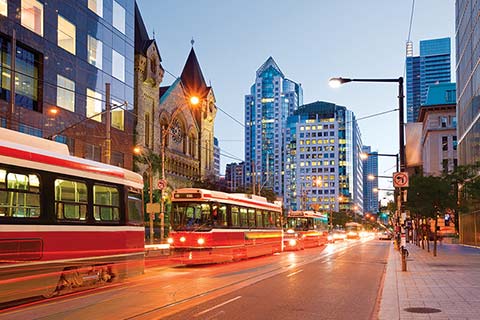In the run-up to last year’s municipal election, Toronto voters identified transportation gridlock as the city’s most pressing issue. Recently, Richard Sommer, dean of the John Daniels Faculty of Architecture, Landscape and Design, spoke with U of T News writer Brianna Goldberg about how to change the experience for commuters in Toronto.
You’ve said that transit in Toronto should be about much more than moving people from A to B. What do you mean? In recent years, the transit discussion here has been too centred on a debate between light rail and subways. We fail to ask questions about the overall network experience we are trying to build, who we’re building it for, and what the bigger picture looks like. It’s distracted us from asking how the way in which our citizens move through the entire city – not just downtown – influences their quality of life.
How do we encourage people to consider alternatives to the car? It has to be in people’s self-interest to get out of their own cars. They need to realize that their life could be improved by cutting their commuting times, or that better transit design and coordination can result in a more pleasant, less stressful way of moving through the city. Torontonians take trips ranging from 20 minutes to two hours. If you map a person’s itinerary, and think about everything from the spaces they travel through to the signage they see to how they use tickets and passes, you can make a big impact on the quality of their commute. It would be great if everyone could ride their bike or walk to work, but it’s a big city and it is often the case that the least economically advantaged people have to travel farther and more often to make a living. So we have to be mindful of what their life is like. The challenge is to ensure that people can move through the city in ways that don’t deaden their spirit.
The book Huburbs, which the Daniels Faculty recently co-published with Metrolinx, has some fresh ideas about how to make suburban transit hubs more appealing. Please explain. Huburbs looks at the inconvenient-to-access and often-ugly transit hubs in the outer GTA. It uses complex documentation, analysis and visually sophisticated models to explore how these hubs could be lively and enriching, instead of barren platforms surrounded by parking lots and vacant space. Our ideas include adding value to these places with new supplemental programs, such as urban farming, retail or educational facilities so they are not just about transit. Can the architecture of these spaces transform seasonally to be more environmentally sound? Can an activity be woven into the space between a GO station and light rail station that leverages local assets in ways that could engage people who move through these hubs, and also attract other investments?
What do you make of the urban-suburban divide, as is often mentioned in the transit debate? Toronto is an urban territory, but it has developed unevenly. I don’t think it’s helpful to say that one place is a suburb, and another is a city. It really has to do with the level of maturation of the geography in question. It’s all urbanization, and some of the most interesting and diverse areas, culturally, are in what some think of as a suburb. To some extent, Toronto’s downtown is taking care of itself. What we’re looking at, especially at the boundaries or edges where growth can occur, are strategies for transforming the whole city.
What should a Torontonian’s transit experience look like 10 or 15 years from now? Our ambition has to be to make the experience of using multiple modes of transit better than driving a conventional car. While using transit in the future, one will be able to read, shop, exercise and socialize. Using transit will be seen as something that is enriching rather than as a sacrifice one has to make.
This Q&A was adapted from two U of T News podcasts about urban issues. Listen to Richard Sommer and other urban experts talk about the future of cities.
Recent Posts
U of T’s 197th Birthday Quiz
Test your knowledge of all things U of T in honour of the university’s 197th anniversary on March 15!
Are Cold Plunges Good for You?
Research suggests they are, in three ways
Work Has Changed. So Have the Qualities of Good Leadership
Rapid shifts in everything from technology to employee expectations are pressuring leaders to constantly adapt





